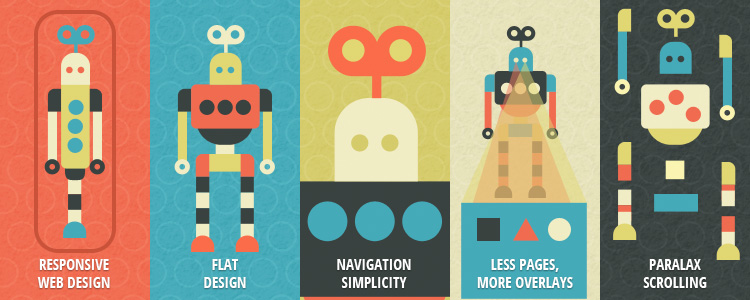
With every year we can expect small and large-scale web design trends from the websites we know, love, and use every day. Already, Twitter has launched its new desktop interface, which looks quite similar to its mobile app. The New York Times also launched its new website, updating key technical features for an optimized user experience but taking typography and design elements back to basics. We’ve compiled a short list of five web design trends we’ve seen across a wide range of websites. These trends will continue to provide strong influence throughout 2014. Use this as a guide when thinking of fun and innovative ways to update your own website.
1. Responsive Web Design (RWD)
A few posts ago, we wrote about the benefits of responsive web design (RWD) and how it is changing the landscape of user experiences across all devices. In the post, we discussed the various benefits of RWD – mainly the use of multi-device adaptation and seamless user experience. RWD has proven to be huge, as it addresses and solves many of the issues users experience on a daily basis. Slow navigation, unsearchable text, and annoying redirects when viewing a website are just some of the frustrations associated with attempting to access a full-sized website on a mobile devices. Let’s face it, a full size website was never intended to be viewed from a tiny cell phone screen! Creating responsive web design, while slightly more costly and time-consuming, proves to be the most effective way to ensure that each user can access your website the way it should be – regardless of device or screen size. At this point I think we can all agree that responsive web design is more than just a trend – it’s a permanent fixture in our industry.
2. Flat Design
The launch of Windows 8 and Apple’s iOS 7 in late 2012 and 2013 made flat design an aesthetically appealing part of our everyday lives. While it strips away the three-dimensional effect formerly considered standard for apps and logos, it allows website designers and graphic designers to get creative with typography and colors. Another great benefit of flat design is that it often creates a finger-friendly type of “clickability” for a website, which automatically optimizes navigation logos and pages for mobile access. This clean and inviting look feeds into a simplified user experience.
3. Design and Navigation Simplicity
Creating a simple, easy-to-use homepage for visitors to see your business online, purchase your product, and find out about your services is imperative for keeping visitors on your page. As previously discussed, flat design is a terrific way to create an aesthetically-pleasing look and feel for your website. However, there are many more ways to simplify your website further. Simple color schemes and even a refresh of your logo help create a fresh look, which keep visitors comfortable while viewing your page. White space and minimalist design provide a visitor with easy-to-decipher navigation, avoiding frustration and potential loss of valuable customers.
4. Less Pages, More Overlays
To keep from losing your visitor’s attention, avoid creating unnecessary page redirects. Many new websites are using web design features such as overlays and expanding tiles to keep users on the same page without redirection. This is particularly popular on eCommerce websites, but can be used to convey any sort of “extra” information that does not need to be displayed unless requested with a click or hover by the user.
5. Parallax Scrolling
Innovative and fun scrolling patterns have taken over website design! This modern feature creates an interactive way for a user to view several screens or layers in an entertaining and eye-catching way. Parallax scrolling is often interactive, incorporating HTML5 animation with moving background parts to keep a visitor engaged. As a visitor scrolls through, images or layers will change direction and location. Although the term layers seems like a juxtaposition to flat design mentioned above, it’s the background images themselves that are layered – and they still remain flat.
While the true nature of trends is the fact that they come and go, we believe these web design trends will stick around for a long time. Innovative and fresh ideas are always a necessity for website design, and we look forward to the exciting new trends the year has in store.